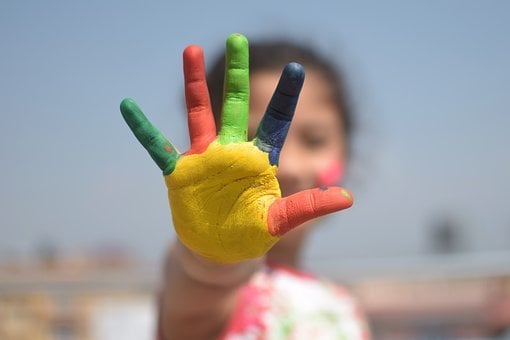Exploring Science with…Art?

Did you know that children can make scientific discoveries while in the Art Center? Adding water to paint, makes it thinner and mixing two colors together can make a completely different color! Using a glue stick can make paper stick together, but not a pipe cleaner to a collage, why? Teachers should encourage these types of investigations through open ended exploration of art materials during their Free Choice Center times. To do this, teachers should provide a wide variety of materials, offer choices that allow plenty of time for children to explore the materials, and focus on the process of art and not the finished product.
While children are engaged in the art area, teachers should ask children scientific questions to provoke children’s thinking or make statements that start with “I wonder...” (for example, “I wonder if there is a way to make this paint a different color” or “I wonder how I can make this clay softer”). For older preschool children, teachers should help children gather and record their data while exploring within the art area as well. One way to do this is by creating a color mixing chart that the children can interact with. Once they have mixed two colors together, this will help to provide a visual of their scientific discoveries. Help the children then examine their data and ask them to explain their findings, for example “What did you notice about the paints when you mixed them?”, “What happened when you added the white paint to the red paint?”, etc.
As the children are discussing their findings, you can either record what they say on paper, take pictures of their discoveries, or help the children write down in their journals to share with the larger group during Circle Time. As the children are engaged in the art area, you must also be sure to introduce new words to help the children learn scientific concepts through their play (i.e., “Purple is made up of red and blue. It is a secondary color”, “The clay is dense, you have to push it really hard with the rolling pin to make it flat”, etc.). Teachers should also provide encouragement and feedback by recognizing small accomplishments and help children notice details within their work (i.e., “I notice that you used water to make the clay softer, that seemed to solve your problem in rolling the clay easier”).
It is also important for teachers to explain reasoning behind actions to help children learn more about what they are experiencing to be able to apply this knowledge to new situations (i.e., “When the clay is dry, it is hard to work with. When you add water, the clay absorbs the water and becomes softer”). Last, but certainly not least, teachers should encourage fun and enjoyment while the children explore the materials.
We here at H&H Child Care Training have created courses to help you on your scientific discoveries, such as:
Tomorrow’s Einsteins: Infant and Toddler Science
Meaningful Lesson Planning for Infants/Toddlers
Project Based Learning for Children
H & H Child Care Training Courses grant .2 CEUs or more as well as awarding state approved clock hours of 2 or more for all childcare centers, and family childcare providers in many states. Check with your licensing agency to check for any additional requirements and to see if we are approved in your home state. Click here to search our vast list of science courses and schedule your next online training today!
- 45 Hour Preschool Methods and Materials
- 45 Hour Child Growth and Development
- Pediatric RSV First Aid & CPR/AED
- Building Early Science Foundations
- Toddlers and Theories
- Open Heart, Open Art
- Art from the Heart for Preschoolers: Open Ended Art Projects that Build Self-Esteem
- Tomorrow's Einsteins: Infant and Toddler Science
- Power of Art: Bldg Self-Esteem & Positive Behavior for ALL Abilities ONLINE
- Exploring Science with…Art?
- Field Trip Guide for Michigan Providers
- Montessori Magic: How to Turn Everyday Household Items into Learning Tools!
- STEAM Playground: How to Turn Your Kitchen into a Science Lab
- Pumpkin Party to Celebrate National Pumpkin Day with Your Students
- Boo-tiful Science: Glow-in-the-Dark STEAM Experiments for Mini Mad Scientists
- Winter Wonders: Incorporating Seasonal Science in Preschool Curriculum
- How Early Educators Can Inspire Big Dreams in Little Minds
- How Does Child-led Learning Elevate Winter Play?
- Play, Explore, Grow: Fresh Curriculum Ideas to Spark Joy in Your Preschool or Daycare
- Spark Young Minds: Playful Scientists: 7 Easy STEM Activities for Preschoolers
- What Are Creative Ways to Use Nature as Your Classroom?
- ❄️ What Outdoor Activities Work Well for Illinois Kids in Every Season? 🌷🍂
- Field Trip Ideas in New York: Engaging, Educational, and Fun Adventures for Children
- Exploring Oklahoma: A Guide to Educational Field Trips for Children
- Open-Ended Art Activities That Build Confidence in Preschoolers